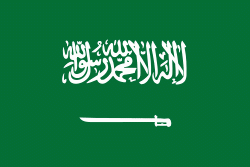Riyadh Air Base (Riyadh Air Base)
Riyadh Air Base (, قاعدة الرياض الجوية), formerly known as Riyadh International Airport from its opening in 1946 until 1982, is a military air base in Riyadh, Saudi Arabia. It was originally used by Saudia as an airline hub before King Khalid International Airport opened in 1982.
Originally used for commercial flights by Saudi Arabia Airlines, the airport witnessed the destruction of Saudia Flight 163 on the night of August 19, 1980. The passengers and crew of the Lockheed L-1011-200, registration HZ-AHK, attempted to evacuate the smoke-filled cabin after landing but were unable to do so, and the aircraft later burst into flames and was destroyed on the tarmac. All 301 people aboard were killed in this disaster.
In 1982, King Khalid International Airport was opened, which led to this airport becoming a Royal Saudi Air Force (RSAF) air base.
Originally used for commercial flights by Saudi Arabia Airlines, the airport witnessed the destruction of Saudia Flight 163 on the night of August 19, 1980. The passengers and crew of the Lockheed L-1011-200, registration HZ-AHK, attempted to evacuate the smoke-filled cabin after landing but were unable to do so, and the aircraft later burst into flames and was destroyed on the tarmac. All 301 people aboard were killed in this disaster.
In 1982, King Khalid International Airport was opened, which led to this airport becoming a Royal Saudi Air Force (RSAF) air base.
Map - Riyadh Air Base (Riyadh Air Base)
Map
Country - Saudi_Arabia
 |
 |
| Flag of Saudi Arabia | |
Pre-Islamic Arabia, the territory that constitutes modern-day Saudi Arabia, was the site of several ancient cultures and civilizations; the prehistory of Saudi Arabia shows some of the earliest traces of human activity in the world. The world's second-largest religion, Islam, emerged in what is now Saudi Arabia. In the early 7th century, the Islamic prophet Muhammad united the population of Arabian Peninsula and created a single Islamic religious polity. Following his death in 632, his followers rapidly expanded the territory under Muslim rule beyond Arabia, conquering huge and unprecedented swathes of territory (from the Iberian Peninsula in the west to parts of Central and South Asia in the east) in a matter of decades. Arab dynasties originating from modern-day Saudi Arabia founded the Rashidun (632–661), Umayyad (661–750), Abbasid (750–1517), and Fatimid (909–1171) caliphates, as well as numerous other dynasties in Asia, Africa, and Europe.
Currency / Language
| ISO | Currency | Symbol | Significant figures |
|---|---|---|---|
| SAR | Saudi riyal | رس | 2 |
| ISO | Language |
|---|---|
| AR | Arabic language |















